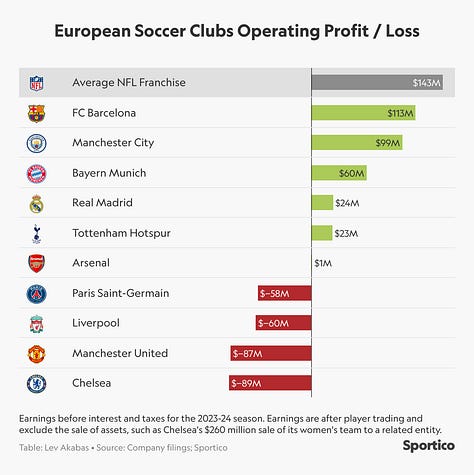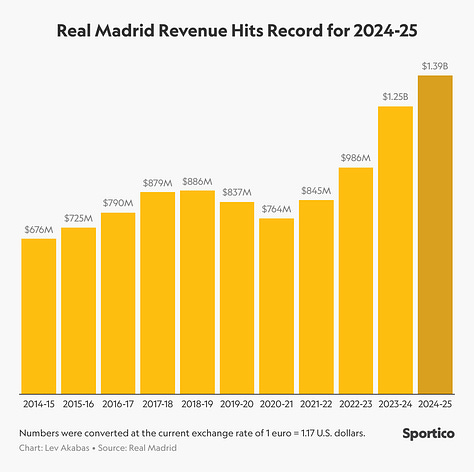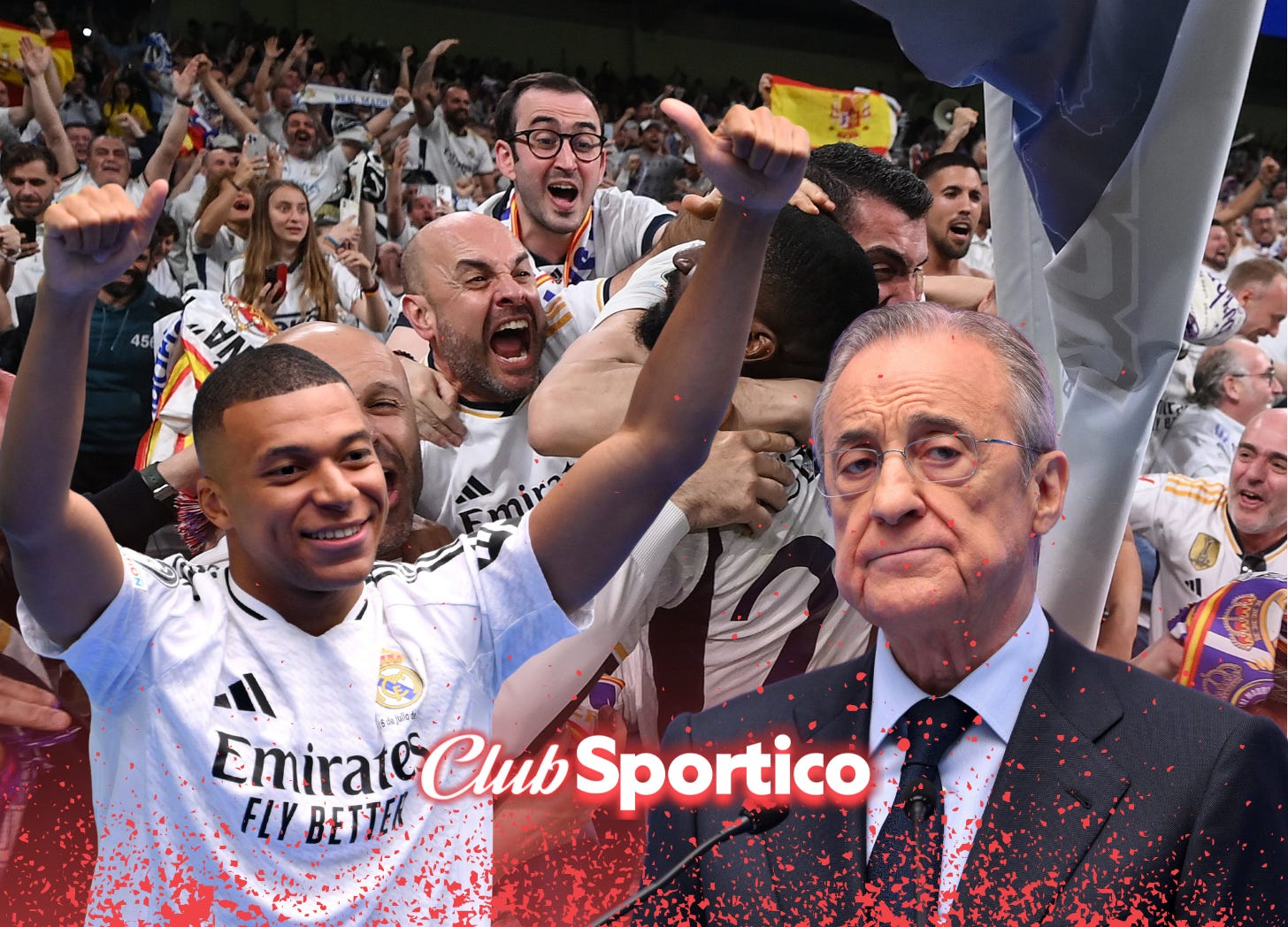Real Madrid is prepping a delicate balancing act
The world’s most valuable soccer team has historically been unable to court new owners. Now it’s trying to raise ~$1 billion without losing its soul.
Welcome back to Club Sportico, where we break down the intersection of sports and money—with an extra bit of humor and opinion. Today, we travel across the Atlantic.
On Sunday morning in Madrid, the man who runs the world’s most valuable soccer team will update its most dedicated fans about his plan to nudge them aside—at least partially.
Real Madrid president Florentino Pérez has spent years thinking about how the team might better capitalize on the rush of outside money into European soccer. At the club’s general assembly meeting this weekend, he is expected to lay out details of a plan to sell a stake in the club for the first time in its 123 year history.
The fact that Real Madrid has an annual “general assembly” highlights the relatively unique space it occupies in major European soccer. Like their rivals FC Barcelona, Los Blancos are owned entirely by a group of avid fans, known colloquially as socios. Since the club’s founding in 1902, those socios have controlled Real Madrid, voting on the club’s leadership, its budget and its general direction.1
It’s worked quite well so far. Real Madrid has won Spain’s domestic league a record 36 times, and has more than twice as many Champions League trophies as the next closest club. Off the field, the team has been equally dominant. During the 2023-24 season Real Madrid became the first soccer team to make more than €1 billion in a single year.2 Last season, it set a new record at €1.185 billion ($1.37 billion based on current exchange rates).
Pérez, however, has been sounding alarm bells about the economics of top-tier European soccer. Billionaires like John Henry (Liverpool 🔴), institutional funds like Clearlake Capital (Chelsea 🔵) and petrostates like Qatar (Paris Saint-Germain🗼) have poured billions into the sport’s biggest teams over the past decade, sending costs soaring. Real Madrid, restricted by its socios model, has largely stayed on the sidelines.
Now, after months of considering multiple models and consulting with lawyers and tax experts, Pérez is reportedly ready to propose a new ownership structure. He’s trying to navigate a lucrative middle ground between the sport’s traditional, fan-centric roots and its spend-happy future. It’s a delicate balancing act, but if he succeeds, he will soon trigger bidding on one of the biggest sports deals in history.
Sportico values Real Madrid at $6.53 billion, the highest of any soccer team in the world. Pérez, on the other hand, puts the number at roughly $11.5 billion (€10 billion), and his number might be closer to the truth. The club’s unique ownership structure makes it hard to fully assess, and Real Madrid is the kind of elite sports brand that rarely hits the market. The team is also finishing a six-year, $2 billion renovation of its Santiago Bernabéu Stadium, which just hosted Spain’s first NFL game and should help the team make money 365 days per year.
At a recent Sportico event in New York, I asked Alex Wicks, who runs the Bernabéu, about what it looks like on days when Los Blancos aren’t playing. He talked about the venue’s six restaurants, its private events and a stadium tour that draws thousands of fans per day.
All Spanish sports teams were fan-owned until the early 1990s, when the government mandated that they move toward a private model that looks more like most major U.S. franchises. Four clubs—Real Madrid, Barcelona, Athletic Bilbao and Osasuna—were granted exemptions to keep their special non-profit status. Under their structure, there are huge tax breaks and no dividends. All revenue must be reinvested in the club.
There are currently about 100,000 Real Madrid socios, a number that is constantly growing, but only with the children or grandchildren of current members. A select number of the total are allowed to vote at the general assembly.3
Pérez, a socio who has been attending Real Madrid games since the 1950s, has served as president since 2009. Over the past decade, while not technically changing the ownership model, he has been able tPérezo lure outside investment of various sorts. In 2017, for example, the team sold a cut of future sponsorship revenue to U.S.-based Providence Equity Partners for €200 million. In 2022, Real Madrid made private equity giant Sixth Street a partner in the Bernabéu project, trading a share of stadium revenue over a 20-year period for €360 million to put toward construction.4 Now, Pérez appears ready to push for a more dramatic change.



It’s unclear, however, what exactly that might look like. The club could create a structure that lets some socios sell out of their ownership. It could also move toward a model similar to what exists in German soccer, where fans are legally required to own a majority of voting rights, but teams have more wiggle room with the other 49.9% of the equity.5 The most likely scenario is one we’ve seen all over global sports in recent years, where the team puts its commercial assets into a separate company, and then adds investors into that entity.6
In all of these scenarios, socios would retain majority control—Pérez has been clear on that. Proponents of this deal will likely point to the ~$1 billion in cash that the club might suddenly have at its disposal. Skeptics will point to the same tension that exists with much of private capital’s push into sports in recent years: It’s hard to turn off the spigot once you turn it on, and institutional investors have very different profit motives than fan-owned clubs.
Consider this Bernabéu detail, courtesy of The Athletic. “Many [socios] season tickets currently cost less than the price of most VIP packages for just one game.” That’s nails on a chalkboard for investors judged primarily on their returns.
But if you’re a fan, doesn’t that sound pretty great?
Jacob’s ⚡ Take: I’m curious to see if socios would prefer giving a slice of their club to a relatively faceless financial firm or a potentially eccentric billionaire. Definitely pros and cons of each. I think I’d lean billionaire, if just for the content?
On the most recent Sporticast episode, Eben and Scott talked about the changes in MLS’s streaming deal with Apple. They also discussed why, even if the partnership hasn’t gone swimmingly for Apple, the tech giant likely wasn’t going to opt out of the original agreement ahead of schedule 👇
Club Sportico is a community organized by Sportico, a digital media company launched in 2020 to cover the business side of sports. You can read breaking news, smart analysis, and in-depth features from Eben, Jacob and their colleagues at Sportico.com, and listen to the Sporticast podcast wherever you get your audio. Contact us at club@sportico.com.
This does not include player signings, like the $246 million package Real Madrid put together to sign Kylian Mbappé.
The Dallas Cowboys crossed the $1 billion mark during the 2022 NFL season. The Los Angeles Dodgers did the same during last year’s World Series run.
If you’re curious about the gritty details of how this works, The Athletic recently provided a really good breakdown.
Barcelona, also socios-owned, has gone through an even more dramatic sell-off of satellite assets.
This model is called the 50+1 Rule, and like the socios structure in Spain, it’s beginng to run up against the sport’s globalist future.
This is basically what the Big Ten has been considering for a while with a California pension fund.






